
Fig. 213

Fig. 214
The first group comprises sixteen magical passes that stir the energy of the left body and the right body, each independently from the other. Each magical pass is performed with either the left arm or the right arm, and in some cases with both at the same time. The arms never go, however, beyond the vertical line that separates the two bodies.
1. Gathering Energy in a Ball from the Front of the Left and the Right Bodies and Breaking It with the Back of the Hand
With the palm of the hand slightly curved and facing the right, the left arm circles inward twice in front of the body (fig. 213). All the muscles of the arm are held tense as this circular motion is executed. Then the back of the hand strikes forcefully to the left as if breaking the top of a ball gathered with the movement of the arm (fig. 214).
The hand strikes a point an arm's length away from the body above the shoulders, at a forty-five-degree angle. While this strike is being executed, all the muscles are kept tense, including the muscles of the arms, a tension that permits controlling the strike. The impact is felt on the areas of the pancreas and spleen and the left kidney and adrenals.
The same movements are repeated on the right side, and the impact is
felt on the areas of the liver and the right kidney and adrenals.

Fig. 213 |

Fig. 214 |
2. Gathering Energy of the Left and Right Bodies in a Circle Which Is Perforated with the Tips of the Fingers
The left forearm is held in front of the body, at a ninety-degree angle in relation to it. The wrist is kept straight. The palm of the hand faces to the right as the fingers point to the front. The thumb is kept locked. As in the previous magical pass, the forearm circles twice, going from the left up to the level of the shoulder and turning toward the center of the body (fig. 215). The elbow is then quickly pulled all the way back, and the circle drawn by the forearm is perforated by the tips of the fingers in a forward thrust (fig. 216). The elbow is moved all the way back once more in order to gain striking power, and then the hand shoots forward again.
The same sequence of movements is performed with the right arm.

Fig. 215 |

Fig. 216 |
3. Hoisting Left and Right Energy Upward
Both knees are slightly bent. The left knee is then raised to the level of the pancreas, fully bent, while the foot is held with the toes pointing to the ground. At the same time that this movement is performed, the left forearm shoots upward until it reaches a point at a forty-five-degree angle with the body; the elbow is kept tight against the body. Both the leg and the arm move in total synchronicity, jolting the midsection (fig. 217).
The same movements are repeated with the right leg and the right arm.
The tendency of energy is to sink, and it is of great importance to spread it upward to the midsection of the body. It is the belief of shamans that the left body is ruled by the area of the pancreas and spleen, and the right body by the area of the liver and gallbladder. Shamans understand this process of hoisting energy as a maneuver to energize those two centers separately.
4. The Up-and-Down Pressure
The left elbow is raised in front of the body to the level of the shoulder, bent at a ninety-degree angle with the forearm. The hand is clenched in a fist, and the wrist is bent toward the right as acutely as possible (fig. 2 18). Using the elbow as a pivot by keeping it at the same position, the forearm is bent downward until it reaches the area right in front of the solar plexus (fig. 219). The forearm then returns to the upright position.
The same movement is performed with the right arm.
This magical pass is used to stir up the energy that exists in an arc
between a point just above the head and in line with the left shoulder
and a point right above the solar plexus.

Fig. 217 |

Fig. 218 |
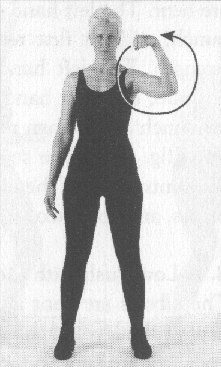
Fig. 219 |
5. The Inward Turn
The first part of this magical pass is exactly like the first part of the preceding one, but instead of bending the forearm downward, it is made to rotate inwardly, making a complete circle, pivoting on the elbow at a forty-five-degree angle with the body. The top of the circle is at a point just above the car and in line with the left shoulder. The wrist is also made to rotate as the circle is drawn (fig. 220).
The same movement is performed with the right hand.
6. The Outward Turn
This magical pass is almost identical to the preceding one, except that instead of turning the left forearm to the right to make a circle, it turns to the left (fig. 221). It makes what don Juan called an outward circle, as opposed to the circle made in the previous magical pass, which he called an inward circle.
The same movement is performed with the right hand.
In this magical pass, the energy stirred is part of the arc of energy
dealt with in the two preceding magical passes. The fourth, fifth, and
sixth magical passes of this group are performed together. Shamans have
found out, by means of their seeing, that human beings have enormous
caches of unused energy lying around inside their luminous spheres. They
have also found out, in this manner, that these magical passes stir the
energy dispersed from the respective centers of vitality-the one around
the liver and the one around the pancreas-which stays suspended for quite
a while before it begins to sink down to the bottom of the luminous sphere.
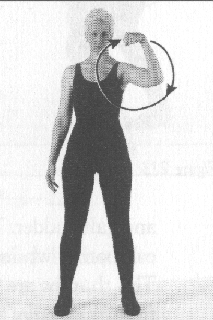
Fig. 220 |
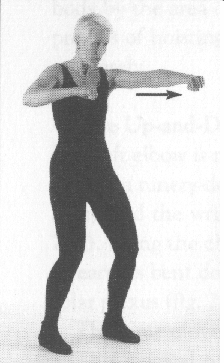
Fig. 221 |
7. A High Push with the Fists
The arms are held in front of the body at the level of the shoulders. The hands are fisted with the palms turned toward the ground. The elbows are bent. The left hand strikes forward with a short punch, without first retrieving the elbow to gain strength. The left hand is retrieved to its initial position; the right hand follows with another similar punch and is then retrieved to its original position (fig. 222). The strike of the fists comes from the contraction of the muscles of the arms, shoulder blades, and abdomen.
8. A Low Push with the Fists
The elbows are bent at a ninety-degree angle and kept at the level of
the waist. They don't touch the body, but are kept an inch or two away
from it. The hands are clenched in fists with the palms facing each other.
The left forearm moves to strike in a short punch, driven by the muscles
of the stomach, which contract in unison with the muscles of the arm and
the shoulder blade (fig. 223). After striking, the forearm is retrieved
instantly, as if the punch has generated the force to push the arm back.
The right arm moves immediately afterward in the same fashion. just as
in the preceding pass, the elbows don't move back to gain striking strength;
the strength is derived solely from the muscular tension of the abdomen,
arms, and shoulder blades.
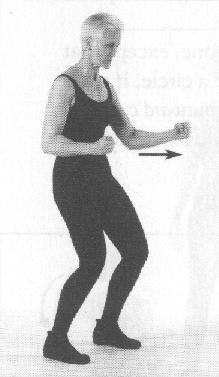
Fig. 222 |

Fig. 223 |
9. A Wheel with the Fingers Contracted at the Middle Joints
The elbows are kept at the level of the waist over the areas of the pancreas and spleen, and the liver
and gallbladder. The wrists are kept straight; the palms of the hands face each other while the fingers are tightly clenched at the second knuckle. The thumbs are locked (fig. 224). The elbows move forward and away from the body. The left hand circles in a vertical rasping motion, as if the bent knuckles were rasping a surface in front of the body. Then the right hand does the same. The two hands move in an alternate fashion in such a manner (fig. 225). The muscles of the abdomen are kept as tight as possible in order to give impetus to this movement.
10. Smoothing Energy Out in Front of the Body
The flat palm of the left hand, which faces forward, is raised to a level just above the head, in front of the body. The palm slides downward in a slanted line and comes to the level of the pancreas and spleen, as if it were smoothing out a vertical surface. Without stopping there, it continues moving to the back; the body rotates to the left to allow the arm to come fully over the head. The hand, with the palm facing downward, then comes down with great force, as if to slap a rubbery substance in front of the area of the pancreas and spleen (fig. 226).
Exactly the same movements are performed with the right arm, but using
the area of the liver and gallbladder as the striking point.

Fig. 224 |

Fig. 225 |

Fig. 226 |
11. Hitting Energy in Front of the Face with an Upward Thrust of the Fist
The trunk turns slightly to the left in order to allow the left arm two full backward rotations going first to the front, above the head, then to the back, where the palm turns slightly inward as if to scoop something from the back (fig. 227). The movement ends at the second turn with an upward thrust of the fisted hand in front of the face (fig. 228).
This magical pass is repeated with the right arm in exactly the same
sequence.

Fig. 227 |

Fig. 228 |
12. Hammering Energy in Front of the Left and Right Bodies
One and a half forward circles are made with the arm, followed by a downward strike; the body rotates slightly in order to allow the left arm a full rotation starting from its initial position by the side of the thigh to the back, above the head, to the front, and again to the side of the thigh. As this circle is made, the palm is made to rotate at the wrist as if the hand were scooping up some viscous matter (fig. 229). From its initial position, the arm moves again to the back and above the head, where the hand turns into a fist that strikes down, with great force, at a point in front of and above the pancreas and spleen, using the soft edge of the hand like a hammer as the striking surface (fig. 230).
The same movements are repeated with the right arm.

Fig. 229 |
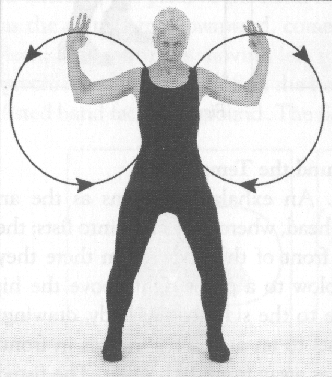
Fig. 230 |
13. Drawing Two Outward Circles of Energy and Smashing Them by the Navel
Both arms move in unison up the front of the body, out to the sides,
and around, like a swimming stroke, to draw two winglike circles at forty-five-degree
angles to the front of the body (fig. 231). Then the circles are broken
at the bottom, at the level of the navel, with a forceful strike of both
hands. The hands are bent at a ninety-degree angle in relation to the forearms,
with the fingers pointing forward. The force of the strike makes the palms
of the hands come within a few inches of each other (fig. 232).

Fig. 231 |

Fig. 232 |
14. Drawing Two Circles of Energy Laterally with the Index and Middle Fingers Extended
The index and middle fingers of both hands are fully extended, while the third and fourth fingers are held by the thumbs against the palms.
The arms circle in unison from their normal position at the sides to
above the head and then laterally to the sides of the body at forty-five
degree angles toward the back (fig. 233). When the full circle is nearly
completed, the fingers contract into fists, leaving the second knuckles
of the middle fingers protruding. The movement ends as the fists, with
the palms facing the body, strike forward and upward, to the level of the
chin (fig. 234).

Fig. 233 |

Fig. 234 |
15. Stirring the Energy Around the Temples
A long inhalation is taken. An exhalation begins as the arms are brought
to a point above the head, where they clasp into fists; the palms of the
fisted hands face the front of the body. From there they strike downward
with a back-fist blow to a point right above the hips (fig. 235). The fisted
hands move to the sides of the body, drawing lateral half-circles that
bring the fists to an area a few inches in front of the forehead and five
or six inches away from each other. The fisted palms face outward (fig.
236). While the exhalation still lasts, the fists are brought to rest on
the temples for an instant. The body leans backward a bit by bending slightly
at the knees to gain spring and momentum, and then the arms are brought
forcefully down, without straightening the elbows, to strike behind the
body on either side with the backs of the fisted hands (fig. 237). The
exhalation ends there.

Fig. 235 |
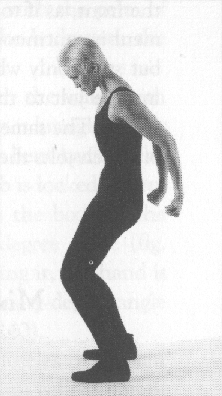
Fig. 236 |

Fig. 237 |
16. Projecting a Small Circle of Energy Out in Front of the Body
From its natural position by the side of the thigh, the left arm moves
outward laterally; the palm of the hand faces the right. It draws a small
circle as the palm turns downward, comes to the area of the pancreas and
spleen, and continues moving left to the level of the waist. The elbow
protrudes acutely (fig. 238a); the hand turns into a fist. The palm of
the fisted hand faces the ground. The fist strikes with a short blow to
the front, as if to pierce the circle it has drawn (fig. 238b). The movement
is continuous; it is not interrupted when the hand turns into a fist, but
stops only when the punch has been delivered. The blow gives an intense
jolt to the center of vitality located around the pancreas and spleen.
The same movement is executed with the right hand, the strike of which
jolts the liver and gallbladder.

Fig. 238a |
Fig. 238b |